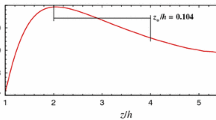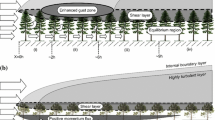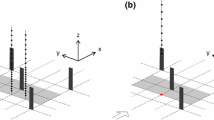Abstract
We investigated the effect of the granularity of heterogeneous forest cover on the momentum absorption by conducting a large-eddy simulation of the flow over a surface covered by square-shaped forest/non-forest patches ranging in size from 64 to 512 m. The modification of the drag coefficient by heterogeneity is analyzed using integral identity equations, which decompose the drag coefficient into contributions from the momentum fluxes, pressure, and forest form drag. From a macroscopic viewpoint, the drag coefficient significantly differs in each case, and its tendency is not monotonic with the granularity. The identity equation shows that the effect of the vertical momentum flux becomes persistent on the non-forest area with an increase in patch size, with the spatial development altering the drag contribution, assigning increasing importance to the forest area. The drag coefficient defined from a local viewpoint shows a strong overshoot at the front edge of the forest patch, with a sudden decrease away from the front edge. A distance of almost 10 forest heights is required to arrive at a nearly homogeneous condition. However, spatial development is still obvious in the mean advection and pressure deviation terms with spanwise heterogeneity inducing an overshoot of the drag coefficient by enhancing the secondary flow. As such, the effect of the edge remains in a transitional manner, even if a locally homogeneous region is observed in the downstream and at the centre of patches.












Similar content being viewed by others
References
Albertson JD, Parlange MB (1999a) Surface length scales and shear stress: implication for land-atmosphere interaction over complex terrain. Water Resour Res 35(7):2121–2132. https://doi.org/10.1029/1999WR900094
Albertson JD, Parlange MB (1999b) Natural integration of scalar fluxes from complex terrain. Adv Water Resour 23:239–252. https://doi.org/10.1016/S0309-1708(99)00011-1
Anderson W, Barros JM, Christensen KT, Awatshi A (2015) Numerical and experimental study of mechanisms responsible for turbulent secondary flows in boundary layer flows over spanwise heterogeneous roughness. J Fluid Mech 768:316–347
Bailey BN, Stoll R (2016) The creation and evolution of coherent structures in plant canopy flows and their role in turbulent transport. J Fluid Mech 789:425–460
Belcher SE (2005) Mixing and transport in urban areas. Philos Trans R Soc Lond A 363(1837):2947–2968
Böhm M, Finnigan JJ, Raupach MR, Hughes DE (2012) Turbulence structure within and above a canopy of bluff elements. Boundary-Layer Meteorol 146:393–419
Bou-Zeid E, Meneveau C, Parlange MB (2004) Large eddy simulation of neutral atmospheric boundary layer flow over heterogeneous surfaces: blending height and effective surface roughness. Water Resour Res 40:W02505. https://doi.org/10.1029/2003WR002475
Bou-Zeid E, Meneveau C, Parlange MB (2005) A scale-dependent Lagrangian dynamic model for large eddy simulation of complex turbulent flows. Phys Fluids 17:025105. https://doi.org/10.1063/1.1839152
Bou-Zeid E, Parlange EB, Meneveau C (2007) On the parameterization of surface roughness at regional scales. J Atmos Sci 64(1):216–227. https://doi.org/10.1175/JAS3826.1
Brunet Y, Finnigan JJ, Raupach MR (1994) A wind tunnel study of airflow in waving wheat: single-point velocity statistics. Boundary-Layer Meteorol 70:95–132
Claussen M (1990) Area-averaging of surface fluxes in a neutrally stratified, horizontally inhomogeneous atmospheric boundary layer. Atmos Environ 24a:1349–1360
Claussen M (1991) Estimation of areally-averaged surface fluxes. Boundary-Layer Meteorol 54:387–410. https://doi.org/10.1007/BF00118868
Coceal O, Thomas TG, Castro IP, Belcher SE (2006) Mean flow and turbulence statistics over groups of urban-like cubical obstacles. Boundary-Layer Meteorol 121(3):491–519
Corke TC, Enloe CL, Wilkinson SP (2010) Dielectric barrier discharge plasma actuators for flow control. Annu Rev Fluid Mech 42:505–529
Deardorff J (1980) Stratocumulus-capped mixed layers derived from a three-dimensional model. Boundary-Layer Meteorol 18:495–527
Dupont S, Brunet Y (2009) Coherent structures in canopy edge flow: a large-eddy simulation study. J Fluid Mech 630:93–128
Dupont S, Bonnefond JM, Irvine M, Lamaud E, Brunet Y (2011) Long-distance edge effects in a pine forest with a deep and sparse trunk space: in situ and numerical experiments. Agric For Meteorol 151:328–344
Finnigan JJ, Shaw RH (2000) A wind tunnel study of airflow in waving wheat: an empirical orthogonal function analysis of the large-eddy motion. Boundary-Layer Meteorol 96:211–255
Finnigan JJ, Shaw RH, Patton EG (2009) Turbulence structure above a vegetation canopy. J Fluid Mech 637:387–424. https://doi.org/10.1017/S0022112009990589
Fu Z, Iwaki Y, Motozawa M, Tsukahara T, Kawaguchi Y (2015) Characteristic turbulent structure of a modified drag-reduced surfactant solution flow via dosing water from channel wall. Int J Heat Fluid Flow 53:135–145
Fukagata K, Iwamoto K, Kasagi N (2002) Contribution of Reynolds stress distribution to the skin friction in wall-bounded flows. Phys Fluids 14:L73–L76
Giometto MG, Christen A, Meneveau C, Fang J, Krafczyk M, Parlange MB (2016) Spatial characterisics of roughness sublayer mean flow and turbulence over a realistic urban surface. Boundary-Layer Meteorol 160:425–452. https://doi.org/10.1007/s10546-016-0157-6
Kasagi N, Fukagata K (2006) The FIK identity and its implication for turbulent skin friction control. Transit Turbul Control 10:297–324
Kanda M, Inagaki A, Miyamoto T, Gryschka M, Raasch S (2013) A new aerodynamic parametrization for real urban surfaces. Boundary-Layer Meteorol 148:357–377
Lopes SA, Palma JMLM, Piomelli U (2015) On the determination of effective aerodynamic roughness of surfaces with vegetation patches. Boundary-Layer Meteorol 156:113–130. https://doi.org/10.1007/s10546-015-0022-z
Mason PJ (1988) The formation of areally-averaged roughness lengths. Q J R Meteorol Soc 114:399–420
Mejia-Alvarez R, Christensen KT (2010) Low-order representations of irregular surface roughness and their impact on a turbulent boundary layer. Phys Fluids 22:015106. https://doi.org/10.1063/1.3291076
Mejia-Alvarez R, Christensen KT (2013) Wall-parallel stereo particle-image velocimetry measurements in the roughness sublayer of turbulent flow overlying highly irregular roughness. Phys Fluids 25:115109. https://doi.org/10.1063/1.4832377
Parlange MB, Brutsaert W (1989) Regional roughness of the landes forest and surface shear stress under neutral conditions. Boundary-Layer Meteorol 48:69–81
Poëtte C, Gardiner B, Dupont S, Harman I, Böhm M, Finnigan J, Hughes D, Brunet Y (2017) The impact of landscape fragmentation on atmospheric flow: a wind-tunnel study. Boundary-Layer Meteorol 163:393–421. https://doi.org/10.1007/S10546-017-0238-1
Poggi D, Katul GG (2008) The effect of canopy roughness density on the constitutive components of the dispersive stresses. Exp Fluids 45:111–121. https://doi.org/10.1007/s00348-008-0467-7
Poggi D, Katul GG, Albertson JD (2004) A note on the contribution of dispersive fluxes to momentum transfer within canopies. Boundary-Layer Meteorol 111:615–621. https://doi.org/10.1023/b:boun.0000016563.76874.47
Porté-Agel F, Meneveau C, Parlange MB (2000) A scale-dependent dynamic model for large-eddy simulation: application to a neutral atmospheric boundary layer. J Fluid Mech 415:261–284
Quadrio M, Ricco P (2004) Critical assessment of turbulent drag reduction through spanwise wall oscillations. J Fluid Mech 521:251–271
Raupach MR, Coppin PA, Legg BJ (1986) Experiments on scalar dispersion within a model plant canopy. Part I: the turbulent structure. Boundary-Layer Meteorol 35:21–52
Raupach MR, Finnigan JJ, Brunet Y (1996) Coherent eddies and turbulence in vegetation canopies: the mixing-layer analogy. Boundary-Layer Meteorol 78(3):351–382. https://doi.org/10.1007/978-94-017-0944-6_15
Raupach MR, Hughes DE, Cleugh HA (2006) Momentum absorption in rough-wall boundary layers with sparse roughness elements in random and clustered distributions. Boundary-Layer Meteorol 120(2):201–218. https://doi.org/10.1007/S10546-006-9058-4
Shaw RH, Schumann U (1992) Large-eddy simulation of turbulent flow above and within a forest. Boundary-Layer Meteorol 61:47–64. https://doi.org/10.1007/bf02033994
Stroh A, Frohnapfel B, Schlatter P, Hasegawa Y (2015) A comparison of opposition control in turbulent boundary layer and turbulent channel flow. Phys Fluids 27:075101. https://doi.org/10.1063/1.4923234
Sullivan P, McWilliams JC, Moeng CH (1994) A subgrid-scale model for large-eddy simulation of planetary boundary-layer flows. Boundary-Layer Meteorol 71(3):247–276
Wieringa J (1976) An objective exposure correction method for average wind speeds measured at a sheltered location. Q J R Meteorol Soc 102:241–253. https://doi.org/10.1002/QJ.49710243119
Wieringa J (1986) Roughness dependent geographical interpolation of surface wind speed average. Q J R Meteorol Soc 112:867–889. https://doi.org/10.1002/QJ.49711247316
Willingham D, Anderson W, Christensen KT, Barros JM (2014) Turbulent boundary layer flow over transverse aerodynamic roughness transitions: induced mixing and flow characterization. Phys Fluids 26:025111
Wood DH (1982) Internal boundary layer growth following a step change in surface roughness. Boundary-Layer Meteorol 22(2):241–244. https://doi.org/10.1007/bf00118257
Yang J, Anderson W (2018) Numerical study of turbulent channel flow over surfaces with variable spanwise heterogeneities: topographically-driven secondary flows affect outer-layer similarity of turbulent length scales. Flow Turbul Combust 100:1–17. https://doi.org/10.1007/s10494-017-9839-5
Yang XIA, Meneveau C (2016) Recycling inflow method for simulations of spatially evolving turbulent boundary layers over rough surfaces. J Turbul 17(1):75–93
Author information
Authors and Affiliations
Corresponding author
Appendix: Derivation of Identity Equations
Appendix: Derivation of Identity Equations
Equations 13 and 17 are derived as follows. We write the Navier–Stokes equations of the mean streamwise velocity component \(\overline{u}_{1}\) as
where \(R=-A-T+P+D_{h}\) (see Eq. 15). A stress-free wall at \(x_{3}/H=1\) is assumed. The momentum absorption by both forest and surface (\(x_{3}/H=0\)), \(-\overline{\tau _{rgh}}/\rho \equiv \int _{0}^{H}{{\overline{C_{for}}}}{\hbox {d}}x_{3}-\overline{\tau _{1,3sfc}}/\rho \) is acquired by integrating Eq. 22 in the \(x_{3}\)-direction from 0 to H,
which is substituted into Eq. 12. Further, Eq. 23 is horizontally averaged and substituted into Eq. 16. The drag coefficients of interest become
A double periodic condition and the boundary conditions of \(\overline{u_{1}u_{3}}=0\) at \(x_{3}=0\) and \(x_{3}=H\) lead to \(\langle R \rangle = 0\). The spatio-temporally constant driving force \(F_{1}\) can be expressed as the properties of the momentum transport. Again, we integrate Eq. 22 in the \(x_{3}\)-direction from 0 to \(x'_{3}\), where \(0< x'_{3}/H < 1\), and subtract from Eq. 23 to give
which is integrated again, first, in \(x'_{3}\) from 0 to \(x''_{3}\), and then in \(x''_{3}\) from 0 to H, which leads to
We apply the partial-integral rule to the double- and triple-integral terms in Eq. 26,
Then, the non-dimensional driving force \(2HF_{1}/u_{ref}^{2}\), which is to be substituted into Eq. 24, becomes
It is noted that \(-i(\overline{\tau ^{\star }}_{13})\) consists of the effect of the Reynolds number \(6/(u_{ref}H/\nu )\), and subgrid-scale stress in the vertical direction \(i(S_{v})\). The substitution of Eq. 28 with \(u_{ref}=\overline{u}_{b}\) into Eq. 24 yields Eq. 13. The derivation of \(C_{d,g}\) in Eq. 17 follows the same approach above. In order to relate the spatially-averaged property of the momentum transport, we consider the horizontal average of Eq. 26 with \(\langle P\rangle \),\(\langle D_{h}\rangle \), and horizontal advection \(\langle A \rangle \) and \(\langle T \rangle \) being zero,
Again, we may apply Eq. 27 to the first term on the r.h.s., and substitute it into \(C_{d,g}\) in Eq. 24, with \(u_{ref}={{\langle {{u}}_{b}\rangle }}\) to acquire Eq. 17. It is also noted that the advection in the vertical direction is compatible in the following way,
We used the boundary conditions at \(x_{3}=0\) and \(x_{3}=H\) of \(\overline{u_{1}u_{3}} = 0\), and this relation is used in a description of Fig. 7.
Rights and permissions
About this article
Cite this article
Nakao, K., Hattori, Y. Effect of the Granularity of Heterogeneous Forest Cover on the Drag Coefficient. Boundary-Layer Meteorol 170, 235–255 (2019). https://doi.org/10.1007/s10546-018-0392-0
Received:
Accepted:
Published:
Issue Date:
DOI: https://doi.org/10.1007/s10546-018-0392-0




